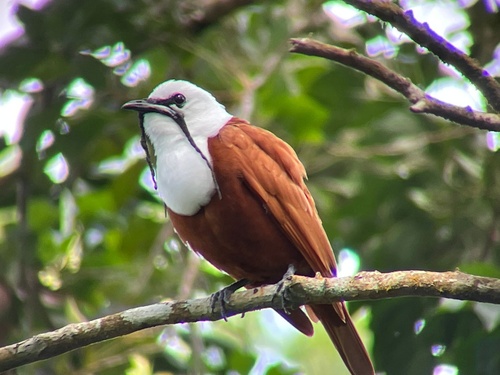
Three-wattled Bellbird
The Three-wattled Bellbird (*Procnias tricarunculatus*) is a strikingly unique bird species renowned for its distinctive appearance and exceptionally loud calls. It plays a crucial role in seed dispersal within its Neotropical forest habitat. This species holds a certain mystique due to its elusive nature and the booming resonance of its calls, which are among the loudest bird vocalizations in the world. It is not widely known in local cultures, but its presence is a strong indicator of healthy, intact cloud forest ecosystems.
25-30 cm
Length
40-45 cm
Wingspan
Vulnerable
Conservation Status
Distribution
The Three-wattled Bellbird is found in Central America, primarily in Honduras, Nicaragua, Costa Rica, and Panama. It exhibits altitudinal migration, breeding in montane cloud forests at elevations of 1200-2500 meters and descending to lower elevations (300-1500m) during the non-breeding season.
Lifespan
Unknown in the wild; potentially 10-15 years based on similar species.
Three-wattled Bellbird's Habitat
Habitat Types
Montane cloud forests, Humid lowland forests (during non-breeding season)
Climate Zones
Tropical, Subtropical
Adaptations
Their strong legs and feet are adapted for perching on branches in the dense cloud forest canopy. Their altitudinal migration is likely an adaptation to track fruiting resources, which vary seasonally with elevation.
Variations
No recognized subspecies exist, but there may be slight regional variations in vocalizations or plumage that have not been formally described.
Appearance
Breeding Plumage
Males have a chestnut-brown body, white head and neck, and three distinctive fleshy wattles at the base of the bill. Females and juveniles are olive-green with yellowish streaks on the underparts, lacking the wattles.
Seasonal Feather Changes
Little to no seasonal variation beyond the differences between breeding and non-breeding plumage.
Sex Based Plumage Differences
Highly pronounced; males and females have vastly different plumage.
Notable Features
Three fleshy wattles extending from the base of the bill (males only), Extremely loud, bell-like vocalizations, Striking contrast between chestnut-brown and white plumage in males
Diet and Feeding
Primary Foods
Fruits (especially from Lauraceae family), Large insects (occasionally)
Foraging Behavior
Primarily frugivorous, the Three-wattled Bellbird forages in the canopy and sub-canopy, plucking fruits while perched or in short sallies. They often swallow fruits whole.
Specializations
Their wide gape allows them to consume large fruits, playing a vital role in seed dispersal for various tree species, especially avocados and other Lauraceae.
Seasonal Diet Variations
Diet shifts with fruit availability, following the fruiting seasons of different tree species at different elevations during their altitudinal migrations.
Behavior
Social Structure
Mostly solitary outside of the breeding season. During breeding, males congregate at leks, while females are more dispersed.
Communication
Extremely loud 'bonk' calls (among the loudest bird calls), Softer 'chok' calls, Visual displays involving wattles and short flights
Migration
Altitudinal migrants, moving between higher-elevation breeding grounds and lower-elevation non-breeding areas. The exact triggers and routes are still being studied.
Territorial or Group Behaviors
Males defend small territories within the lek, primarily through vocalizations and displays. Females do not appear to be territorial.
Conservation
Threats
Habitat loss and fragmentation (due to deforestation for agriculture and cattle ranching), Climate change (potentially altering cloud forest ecosystems), Illegal trapping for the pet trade (though less common)
Protection Programs
Protected areas within their range (e.g., national parks and reserves), Community-based conservation initiatives, Research and monitoring efforts
Local National Laws
Protected under national laws in Costa Rica, Panama, Honduras, and Nicaragua.
Population Trend
Decreasing
Population Estimates
Estimated at 20,000-49,999 mature individuals, but numbers are declining.
Interesting Facts
The male's 'bonk' call can reach 100 decibels, comparable to a chainsaw.
This extreme loudness is an adaptation for attracting females across long distances in dense forest.
The wattles are not just ornamental; they are thought to play a role in vocal resonance.
The exact mechanism is not fully understood, but they may act as resonators, amplifying the sound.
They are important seed dispersers for many cloud forest trees.
By consuming and defecating seeds, they help maintain forest diversity and regeneration.
Faqs about Three-wattled Bellbird
What is the purpose of the three wattles?
The wattles are believed to play a role in vocal resonance, amplifying the male's incredibly loud calls. They are also used in visual displays during courtship.
How loud is the Three-wattled Bellbird's call?
The call can reach 100 decibels, making it one of the loudest bird calls in the world.
Where can I see a Three-wattled Bellbird?
They are found in the cloud forests of Central America (Honduras, Nicaragua, Costa Rica, and Panama). Visiting protected areas within their range during the breeding season offers the best chance of seeing or hearing them.
Are Three-wattled Bellbirds endangered?
They are classified as Vulnerable by the IUCN due to habitat loss and declining populations. While not yet Endangered, continued conservation efforts are crucial.
Copyright @ Nature Style Limited. All Rights Reserved.
 English
English